How to choose poe switch for security camera system?
Power over Ethernet (PoE) switches now serve as the foundation for contemporary IP camera systems. They streamline cabling by delivering both power and data through a single Ethernet cable, presenting flexible solutions for both home and business surveillance. Despite their advantages, the abundance of options makes choosing the ideal PoE switch for your IP camera system a daunting task. This guide aims to dissect the key factors you should weigh, empowering you to make an informed decision that aligns with your unique requirements.
Table of ContentsPart2: How to Choose The Suitable PoE Switch for Security Camera Systems
Part3: Connecting IP Cameras to a PoE Switch: Simplified Steps
Part4: Conclusion
Part1: Do I need PoE switch for IP camera?
Before exploring the criteria for selection, it's essential to grasp the significance of PoE switches in IP camera systems.
Streamlined Cabling: PoE technology facilitates the transmission of both power and data through a single Ethernet cable. This simplifies the cabling process and reduces installation costs.
Extended Cable Reach: Power over Ethernet switch allows the installation of IP cameras at greater distances from the power source. This flexibility is particularly beneficial for outdoor and extensive surveillance systems.
Multiple Device Connectivity: Available in various port configurations, PoE switches enable the connection of multiple IP cameras and other PoE devices to a single switch.
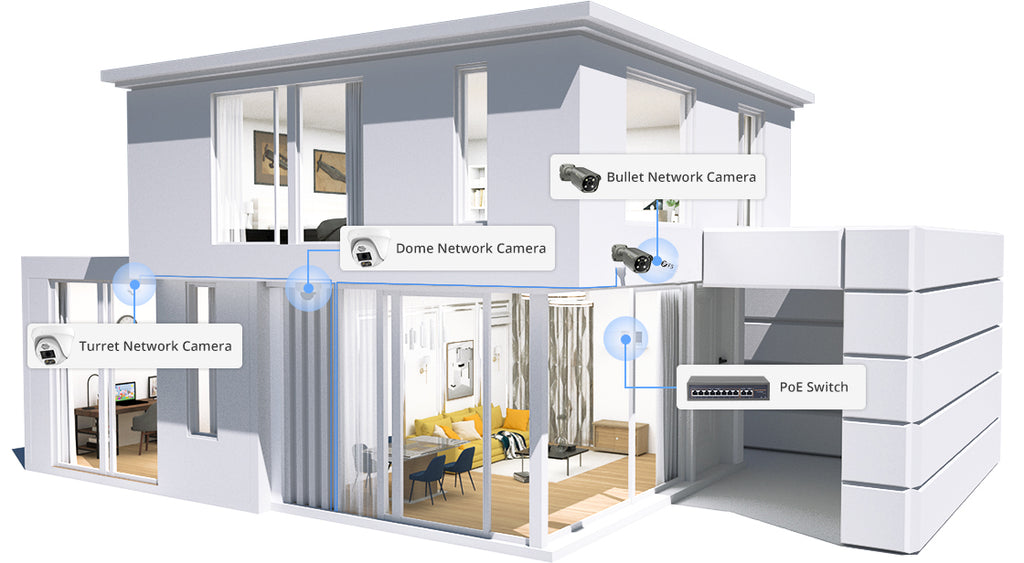
When embarking on the journey of selecting a PoE switch for your IP camera system, several factors warrant careful consideration to ensure optimal performance and seamless integration. Let's delve into the key aspects that can guide you through this decision-making process.
Part2: How to Choose The Suitable PoE Switch for Security Camera Systems?
-
Power Requirements:Start by assessing the power needs of your IP cameras. Different cameras have varying power consumption levels, and your PoE switch should provide ample power to accommodate all connected devices. Consider future expansions and potential power fluctuations.
-
Port Configuration:Examine the number and type of ports the Power over Ethernet switchs offers. Ensure it aligns with the number of IP cameras you plan to connect, allowing room for scalability. Additionally, check for Gigabit Ethernet ports to facilitate high-speed data transfer.
-
Budget Considerations:Evaluate your budget constraints and find a PoE switch that strikes a balance between functionality and cost-effectiveness. While advanced features are enticing, ensure they align with your specific needs without unnecessary expenses.
-
Managed vs. Unmanaged Switches:Determine whether you need a managed or unmanaged PoE switch. Managed switches offer advanced features like remote configuration and monitoring, suitable for larger, more complex setups. Unmanaged switches, on the other hand, are simpler and cost-effective for basic installations.
-
Installation Environment:Consider the physical environment where the PoE switch will be installed. For outdoor deployments, ensure the switch is weatherproof and designed to withstand harsh conditions. Indoor installations may have different requirements, such as compact designs for space efficiency.
-
PoE Standards:Verify that the PoE switch adheres to industry standards like IEEE 802.3af or 802.3at. This ensures compatibility with a wide range of PoE-enabled devices, preventing issues with power delivery.
-
Integration with Network Infrastructure:Ensure seamless integration with your existing network infrastructure. The PoE switch should be compatible with your network equipment, routers, and switches to avoid compatibility issues.
-
Quality of Service (QoS):Prioritize switches with Quality of Service features to prioritize critical data traffic. This ensures that video data from IP cameras receives precedence, maintaining smooth and uninterrupted surveillance.
Real-World Installation Example:
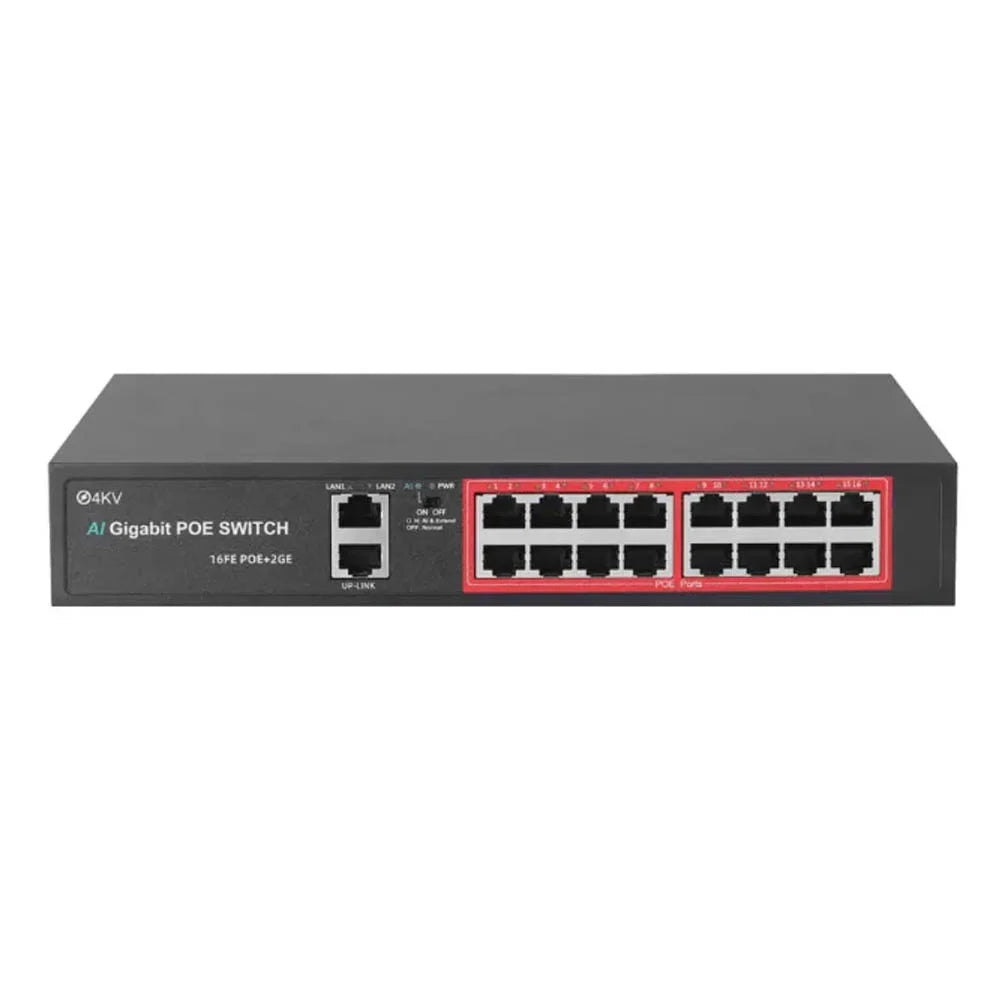
PoE Switch With 16 POE Ports +2 Gigabit Uplink
Extend function extending max power and data transmission distance from 100 meters(330ft) to 250 meters(820ft)
Learn MoreConsider a scenario where a small business owner wants to secure their premises with eight IP cameras. They opt for a 12-port managed PoE switch with ample power capacity for future expansions. The switch is strategically installed indoors, providing Gigabit Ethernet connectivity for high-speed data transfer. Its compatibility with IEEE 802.3at standards ensures reliable power delivery to each camera, and Quality of Service features prioritize video data for uninterrupted surveillance.
By meticulously evaluating these considerations and applying them to real-world scenarios, you can confidently navigate the landscape of choosing a PoE switch for your IP camera system. Each decision contributes to the overall effectiveness and reliability of your surveillance infrastructure.
Part3: Connecting IP Cameras to a PoE Switch: Simplified Steps
Connecting IP cameras to a PoE switch might seem intricate, but the process is quite straightforward. Here's a concise set of steps to guide you:

Use an Ethernet cable (Cat5e or Cat6) to link your router to the LAN port on the PoE switch.
Power Supply:
Plug the power cable into the PoE switch and connect it to a power outlet or surge protector.
Camera Integration:
Connect your IP cameras to the available ports on the PoE switch using Ethernet cables.
NVR Setup:
Add the IP cameras to your Network Video Recorder (NVR) for both viewing and recording.
Remote Access (Optional):
If remote access is required, connect your router to the internet.
With these simple steps, you'll have your IP cameras seamlessly integrated with a PoE switch, ensuring efficient surveillance functionality.
Part4: Conclusion
Selecting the appropriate PoE switch is crucial in establishing a robust and dependable IP camera system. Key considerations, including port numbers, power supply voltage, power budget, maximal power supply, bandwidth capacity, and the choice between managed and unmanaged switches, allow you to customize your selection based on your unique requirements.
Explore our range of unmanaged and managed PoE switches, available in 4-port ,8-port, 16-port and industrial configurations, designed to cater to various IP camera security systems. For additional details, explore Techage PoE Switches.
Have questions or tips to share? Drop a comment below and let's get the conversation started! We will get back to by emails.




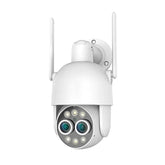





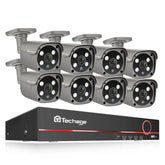

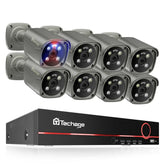



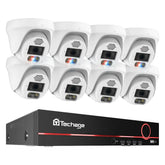
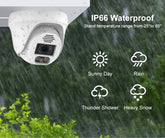








































































































1 comment